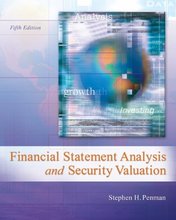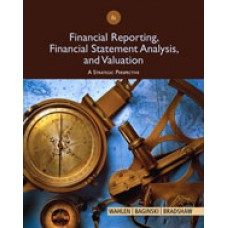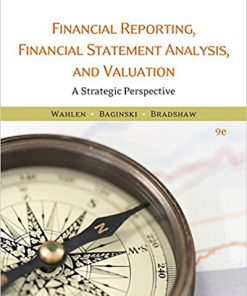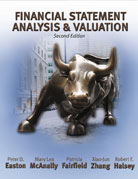Test Bank for Financial Reporting, Financial Statement Analysis and Valuation, 8th Edition
$35.00 Original price was: $35.00.$26.50Current price is: $26.50.
Test Bank for Financial Reporting, Financial Statement Analysis and Valuation, 8th Edition
Test Bank for Financial Reporting, Financial Statement Analysis and Valuation, 8th Edition
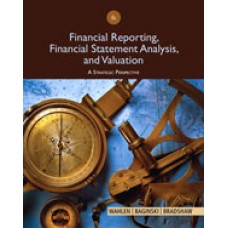
Product details:
- ISBN-10 : 1285190904
- ISBN-13 : 978-1285190907
- Author: James M. Wahlen
FINANCIAL REPORTING, FINANCIAL STATEMENT ANALYSIS, AND VALUATION, 8E is written with the premise that the user can learn financial statement analysis most effectively by performing the analysis on real-world companies. Wahlen/Baginski/Bradshaw’s textbook will teach users how to integrate the concepts from economics, finance, business strategy, accounting, and other business disciplines through a unique six-step process.
Table contents:
- Ch 1: Overview of Financial Reporting, Financial Statement Analysis, and Valuation
- Ch 1: Learning Objectives
- Ch 1: Chapter Overview
- Overview of Financial Statement Analysis
- Step 1: Identify the Industry Economic Characteristics
- Step 2: Identify the Company Strategies
- Step 3: Assess the Quality of the Financial Statements
- Step 4: Analyze Profitability and Risk
- Step 5: Prepare Forecasted Financial Statements and Step 6: Value the Firm
- Role of Financial Statement Analysis in an Efficient Capital Market
- Sources of Financial Statement Information
- Ch 1: Summary
- Ch 1: Questions, Exercises, Problems, and Cases
- Integrative Case 1.1: Starbucks
- Case 1.2: Nike: Somewhere between a Swoosh and a Slam Dunk
- Ch 2: Asset and Liability Valuation and Income Recognition
- Ch 2: Chapter Overview
- Ch 2: Learning Objectives
- Introduction to the Mixed Attribute Accounting Model
- Asset and Liability Valuation and the Trade-Off between Relevance and Representational Faithfulness
- Income Recognition
- Income Taxes
- Framework for Analyzing the Effects of Transactions on the Financial Statements
- Ch 2: Summary
- Ch 2: Questions, Exercises, Problems, and Cases
- Integrative Case 2.1: Starbucks
- Ch 3: Income Flows versus Cash Flows: Understanding the Statement of Cash Flows
- Ch 3: Learning Objectives
- Ch 3: Chapter Overview
- Purpose of the Statement of Cash Flows
- The Relations among the Cash Flow Activities
- Cash Flow Activities and a Firm’s Life Cycle
- Understanding the Relations among Net Income, Balance Sheets, and Cash Flows
- Preparing the Statement of Cash Flows
- Usefulness of the Statement of Cash Flows for Accounting and Risk Analysis
- Ch 3: Summary
- Ch 3: Questions, Exercises, Problems, and Cases
- Integrative Case 3.1: Starbucks
- Case 3.2: Prime Contractors
- Case 3.3: W. T. Grant Company
- Ch 4: Profitability Analysis
- Ch 4: Learning Objectives
- Ch 4: Chapter Overview
- Overview of Profitability Analysis Based on Various Measures of Income
- Return on Assets (ROA)
- Return on Common Shareholders’ Equity (ROCE)
- Economic and Strategic Factors in the Interpretation of ROA and ROCE
- Benefits and Limitations of Using Financial Statement Ratios
- Ch 4: Summary
- Ch 4: Questions, Exercises, Problems, and Cases
- Integrative Case 4.1: Starbucks
- Case 4.2: Profitability and Risk Analysis of Walmart Stores
- Ch 5: Risk Analysis
- Ch 5: Learning Objectives
- Ch 5: Chapter Overview
- Disclosures Regarding Risk and Risk Management
- Analyzing Financial Flexibility by Disaggregating ROCE
- Analyzing Short-Term Liquidity Risk
- Analyzing Long-Term Solvency Risk
- Analyzing Credit Risk
- Analyzing Bankruptcy Risk
- Measuring Systematic Risk
- Ch 5: Summary
- Ch 5: Questions, Exercises, Problems, and Cases
- Integrative Case 5.1: Starbucks
- Case 5.2: Massachusetts Stove Company—Bank Lending Decision
- Case 5.3: Fly-by-Night International Group: Can This Company Be Saved?
- Ch 6: Accounting Quality
- Ch 6: Learning Objectives
- Ch 6: Chapter Overview
- Accounting Quality
- Earnings Management
- Accounting Quality in the Liability Recognition and Measurement Area
- Asset Recognition and Measurement
- Specific Events and Conditions That Affect Earnings Persistence
- Tools in the Assessment of Accounting Quality
- Financial Reporting Worldwide
- Ch 6: Summary
- Ch 6: Questions, Exercises, Problems, and Cases
- Integrative Case 6.1: Starbucks
- Case 6.2: Citi: A Very Bad Year
- Case 6.3: Arbortech: Apocalypse Now
- Ch 7: Financing Activities
- Ch 7: Learning Objectives
- Ch 7: Chapter Overview
- Equity Financing
- Net Income, Retained Earnings, Accumulated Other Comprehensive Income, and Reserves
- Debt Financing
- Leases
- The Use of Derivatives to Hedge Interest Rate Risk
- Expected Rule Changes in Accounting for and Reporting of Debt Financing
- Ch 7: Summary
- Ch 7: Questions, Exercises, Problems, and Cases
- Integrative Case 7.1: Starbucks
- Case 7.2: Oracle Corporation: Share-Based Compensation Effects/Statement of Shareholders’ Equity
- Case 7.3: Long-Term Solvency Risk: Southwest and Lufthansa Airlines
- Ch 8: Investing Activities
- Ch 8: Learning Objectives
- Ch 8: Chapter Overview
- Investments in Long-Lived Operating Assets
- What Choices Are Managers Making to Allocate Acquisition Costs to the Periods Benefited?
- What Is the Relation between the Book Values and Market Values of Long-Lived Assets?
- Investments in Securities
- Primary Beneficiary of a Variable-Interest Entity
- Foreign Currency Translation
- Ch 8: Summary
- Ch 8: Questions, Exercises, Problems, and Cases
- Integrative Case 8.1: Starbucks
- Case 8.2: Disney Acquisition of Marvel Entertainment
- Ch 9: Operating Activities
- Ch 9: Learning Objectives
- Ch 9: Chapter Overview
- Revenue Recognition
- Expense Recognition
- Income Taxes
- Pensions and Other Postretirement Benefits
- Use of Derivative Instruments to Hedge Foreign Currency and Commodity Price Risk
- Ch 9: Summary
- Ch 9: Questions, Exercises, Problems, and Cases
- Integrative Case 9.1: Starbucks
- Case 9.2: Arizona Land Development Company
- Case 9.3: Coca-Cola Pensions
- Ch 10: Forecasting Financial Statements
- Ch 10: Learning Objectives
- Ch 10: Chapter Overview
- Introduction to Forecasting
- Preparing Financial Statement Forecasts
- Step 1: Project Revenues
- Step 2: Project Operating Expenses
- Step 3: Project Operating Assets and Liabilities on the Balance Sheet
- Step 4: Project Financial Leverage, Financial Assets, Common Equity Capital, and Financial Income It
- Step 5: Project Provisions for Taxes, Net Income, Dividends, and Retained Earnings
- Step 6: Balance the Balance Sheet
- Step 7: Project the Statement of Cash Flows
- Shortcut Approaches to Forecasting
- Test the Validity of the Forecast Assumptions and Results by Analyzing Projected Financial Statement
- Sensitivity Analysis
- Reactions to Announcements
- Ch 10: Summary
- Ch 10: Questions, Exercises, Problems, and Cases
- Integrative Case 10.1: Starbucks
- Case 10.2: Massachusetts Stove Company: Analyzing Strategic Options
- Ch 11: Risk-Adjusted Expected Rates of Return and the Dividends Valuation Approach
- Ch 11: Learning Objectives
- Ch 11: Chapter Overview
- The General Valuation Model
- Equivalence among Dividends, Cash Flows, and Earnings Valuation
- Risk-Adjusted Expected Rates of Return
- Dividends-Based Valuation: Rationale and Basic Concepts
- Dividends-Based Valuation: Advanced Concepts
- The Dividends-Based Valuation Model
- Applying the Dividends-Based Valuation Model to Value PepsiCo
- Sensitivity Analysis and Investment Decision Making
- Ch 11: Summary
- Ch 11: Questions, Exercises, Problems, and Cases
- Integrative Case 11.1: Starbucks
- Ch 12: Valuation: Cash-Flow-Based Approaches
- Ch 12: Learning Objectives
- Ch 12: Chapter Overview
- Rationale for Cash-Flow-Based Valuation
- Measuring Free Cash Flows
- Cash-Flow-Based Valuation Models
- Free Cash Flows Valuation of PepsiCo
- Sensitivity Analysis and Investment Decision Making
- Ch 12: Summary
- Ch 12: Questions, Exercises, Problems, and Cases
- Integrative Case 12.1: Starbucks
- Case 12.2: Holmes Corporation
- Ch 13: Valuation: Earnings-Based Approach
- Ch 13: Learning Objectives
- Ch 13: Chapter Overview
People also search:
financial reporting financial statement analysis and valuation 9th edition
financial reporting financial statement analysis and valuation
c corporation financial statements example
analyzing financial statements 8th edition
journal of financial statement analysis
financial analysis financial statement
You may also like…
Solution Manual
Solution Manual for Financial Statement Analysis and Security Valuation 5th Edition by Penman
Solution Manual
Solution Manual
Solution Manual for Financial Reporting, Financial Statement Analysis and Valuation, 8th Edition
Solution Manual
Solution Manual for Financial Statement Analysis and Valuation 2nd Edition by Easton








